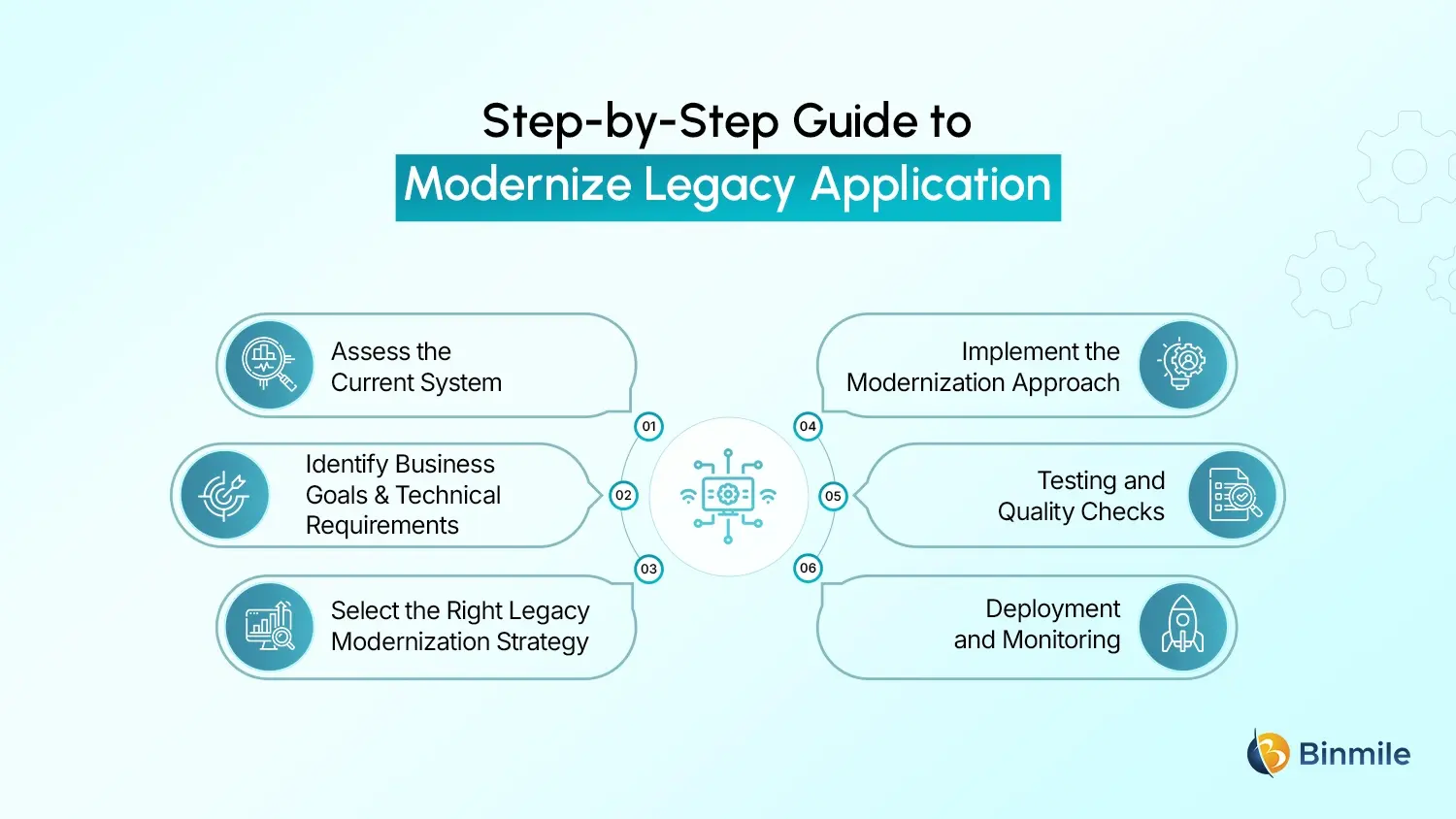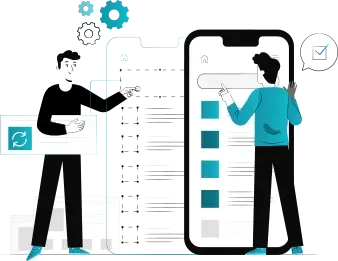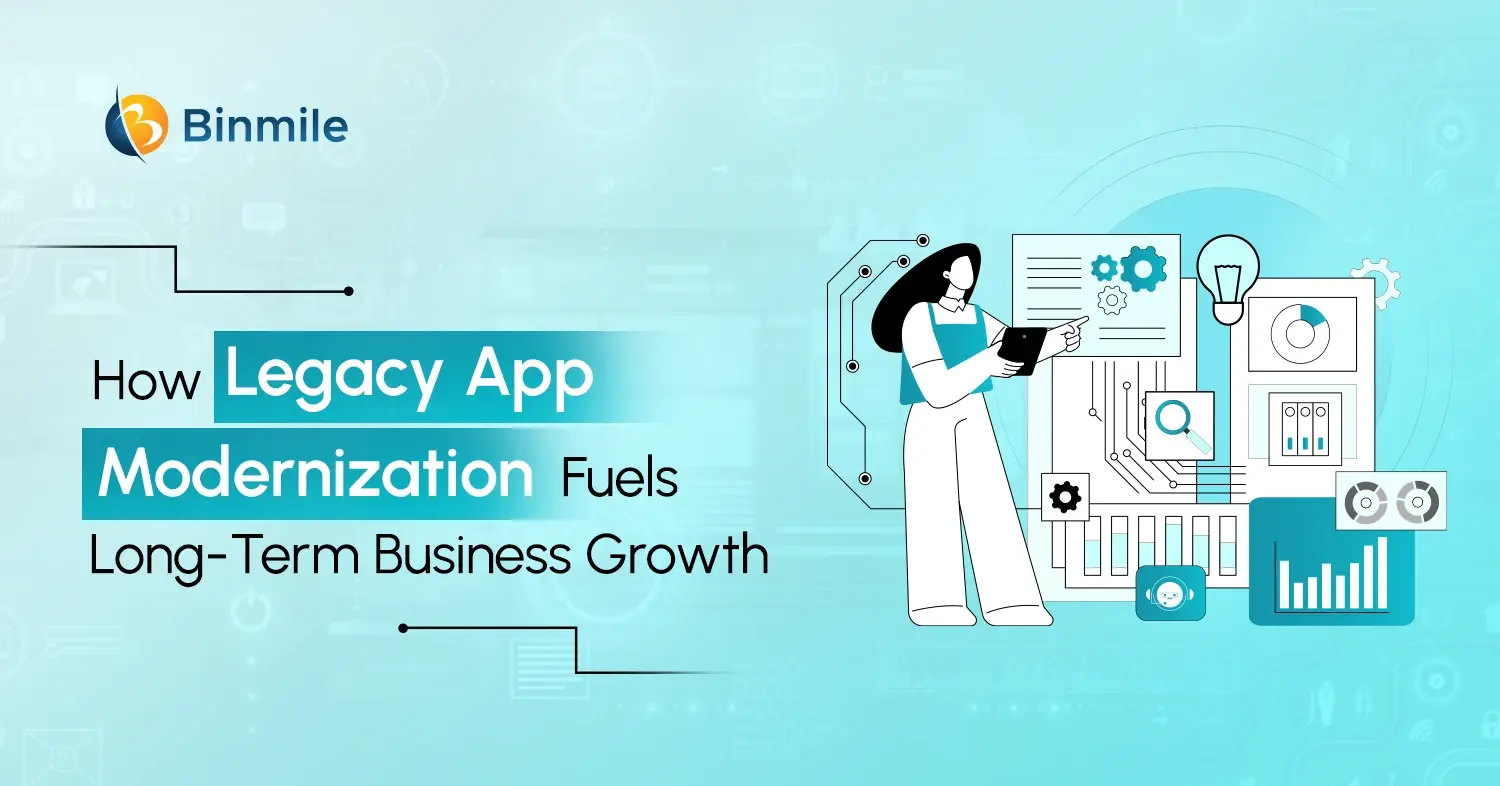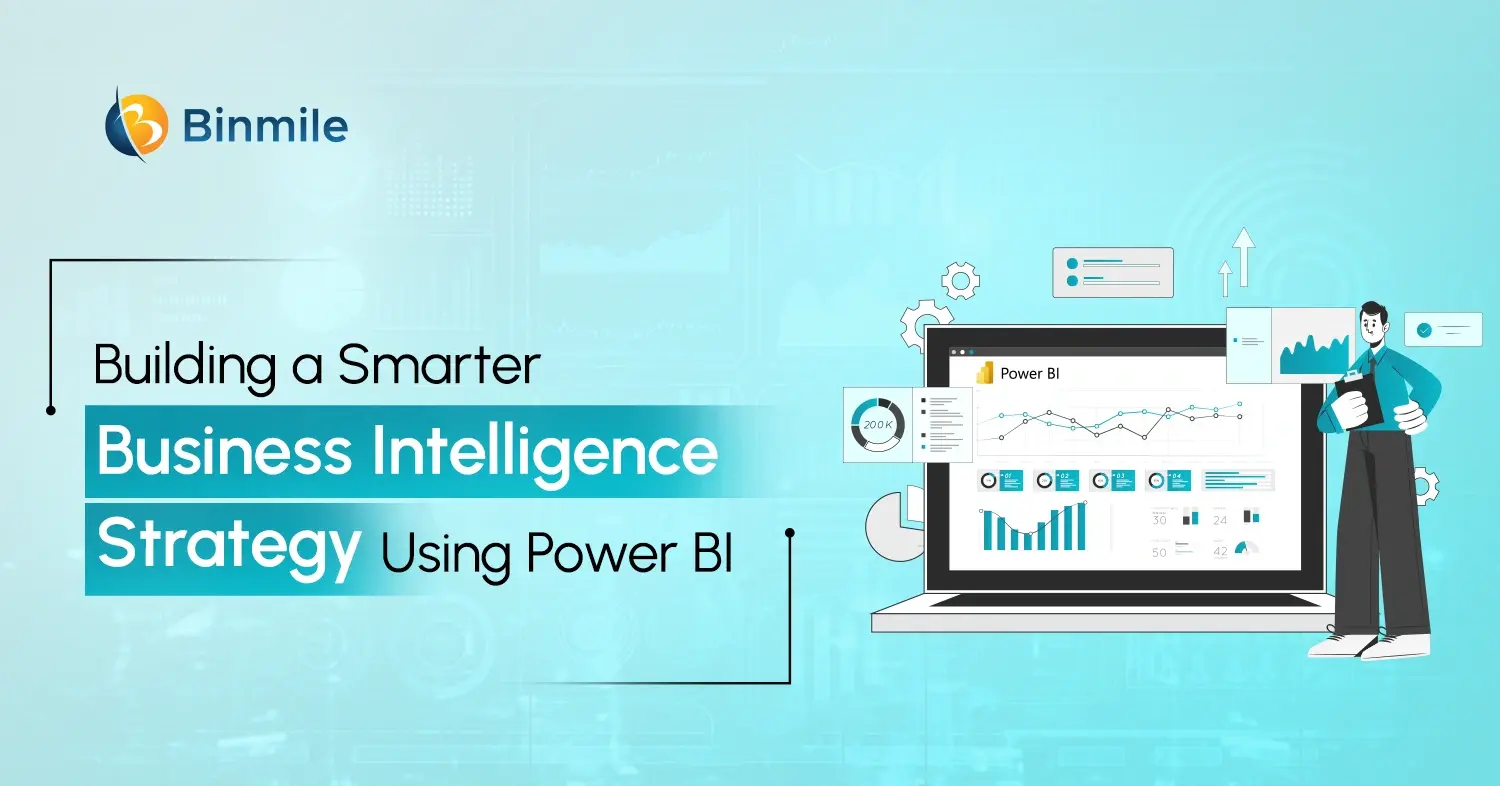Most organizations today are beginning to realize that relying on outdated applications slows down decision-making and overall growth. According to a report by McKinsey, companies that adopt modern technologies in time can see up to a 30 percent improvement in operational efficiency.
This shift toward efficiency is one of the strongest reasons businesses are rethinking the future of their legacy applications and planning for robust Legacy App Modernization strategies.
In this blog, we will look at what legacy software actually means, the challenges it creates, and why modernizing these applications is becoming essential for business continuity and digital transformation in business. We will also explore the step-by-step legacy application modernization process and how a trusted partner can support this journey by implementing legacy application modernization best practices and software development services. This will help in understanding not just the approach, but also how to make smarter decisions. Additionally, it will give a clearer understanding of how to minimize risks and reduce downtime.
What is Legacy Application Modernization?
Legacy applications are software systems that were once the backbone of business operations but now struggle to meet modern performance needs. These systems often lack new, compatible functionalities and perform poorly due to their outdated technologies and infrastructure. Adapting legacy software modernization to meet current demands involves updating and modifying it to retain core business logic while achieving modern compatibility across architecture, cloud services, and customer-centered needs. Many organizations also incorporate custom mobile app development during this stage to enhance overall user experience.
With legacy systems, if they are large and complex, their code can be rewritten, migrated to a new cloud infrastructure, and updated software can be used. Modernization improves performance and security, lowers costs, and removes tedious technical barriers that slow down a company’s ability to innovate.
Benefits of Legacy Application Modernization
Modernizing outdated applications brings several benefits that impact business growth. Some of the most important advantages include:
-
Better Performance and Scalability
Legacy software has difficulty managing high volumes of traffic and increasing workloads. The better optimization of applications means they can scale without a hitch, even during busy business hours. This will be a key aspect of legacy enterprises looking to digitally transform and expand.
-
Lower Maintenance Costs
Old systems have a high need for maintenance and upkeep. This means increased downtime, needing to be patched more often, and a need for guidance through manual labor. New systems architect compute in such a way that maintenance becomes simpler, automated, and more cost-effective. This empowers companies to do more in innovation rather than as a full-time job of maintenance.
-
Improved Security and Compliance
Many legacy systems get even more legacy than usual, as they become the low-hanging fruit of a target for a multitude of cyber-attacks. New systems can support more than basic compliance as they support features of advanced authentication, monitoring dashboards, and even encryption.
-
Enhanced User and Customer Experience
Everyone knows the frustrations of using systems that lack current software. They can cause all kinds of aggravations to customers. New systems have improved software, better integration of data, responsiveness, and more seamless interfaces.
-
Better Integration Capabilities
New systems support improved APIs, cloud migration, and even real-time data sharing. This allows teams to access data instantly and remove barriers to collaboration.
Looking to modernize your legacy applications and accelerate your business growth?

How to Modernize Legacy Apps? (A Step-by-Step Process)
The legacy application modernization process is not the same for every organization. However, some common steps form the foundation.
Step 1: Assess the Current System
The initial stage consists of knowing the legacy systems, the technologies integrated, and the problems or other challenges these systems have. This allows assessing the problems and understanding if the application requires rehosting, refactoring, rearchitecting, or new construction entirely.
Step 2: Identify Business Goals and Technical Requirements
Updates on technology should not overshadow the modernization of systems. This should also harmonize with the other long-term objectives of decreasing operational costs, improving user interaction, refining processes, and integrating additional technologies.

Step 3: Select the Right Legacy Modernization Strategy
This is also a very crucial point. A redesign may also be needed for some applications, while others may require gradual, minimal upgrades to the system. Microservices migration, migration to the cloud, reorganization of code, or changes to the relational database that is used can all be part of the legacy modernization strategy.
Step 4: Implement the Modernization Approach
Once you choose the strategy, technical processes can begin. These processes may include reengineering modules, cloud data migration, implementing containerization, or revising application architecture. For the application to be considered modern, it needs to have robust security and a flexible architecture.
Step 5: Testing and Quality Checks
After implementation, each deployed system should be tested for performance, security, and usability. A combination of automated and user acceptance testing ensures the version works smoothly before going live.
Step 6: Deployment and Monitoring
The final stage involves placing the upgraded system into production. Monitoring tools integrate to offer real-time performance tracking and automatic anomaly detection. This systemization of continuous improvement ensures system reliability.
Why Legacy App Modernization Is Important for Your Business Growth in 2026?
The year 2026 is expected to be a period of aggressive digital adoption across industries. Most companies will operate through hybrid cloud systems, automated workflows, data-driven decision making, and customer-centric digital platforms. Businesses that still depend on legacy software risk falling behind.
Here are the key reasons why modernization becomes essential for long-term business growth.
-
Rising Customer Expectations
Customers today expect services to be available in real-time and for websites and applications to work without any issues. Even with modern applications, how people interact with technology is tailored differently. Organizations that modernized their technology even further can create applications that are personalized, responsive in real-time, and perform consistently.
-
Dependence on Cloud and AI Technologies
The use of Cloud technology and AI development is becoming a standard for business functionality. Legacy technology does not support modern business efficiently. Newer, modernized applications support integration with cloud technology, analytical tools, and AI, which helps businesses to maintain a competitive advantage.

-
Operational Efficiency and Automation
From a business perspective, the ability of a team to work effectively hampers when they have to rely on tedious and arduous manual processes. Additionally, organizations with modernized technology are able to automate their core business operational processes, utilize real-time dashboards, and minimize their repetitive tasks. This results in a more productive environment, which also minimizes errors.
-
Cost Reduction and Higher ROI
Keeping legacy systems operational with antiquated technology is very costly. Once legacy systems modernization happens, they are less costly to maintain, and they consume fewer operational resources. Legacy systems incur substantial costs in energy use, hardware, and support. In the long term, the costs of continuing to support legacy systems are higher than the costs of modernizing the systems.
-
Improved Security for Business Data
Cyber threats are becoming more advanced every year. Legacy software has a limited ability to meet modern security standards and compliance laws. Upgraded systems provide advanced protection, continuous monitoring, and regular patches, which are needed in 2026 and beyond.
Need support upgrading outdated systems without disrupting your day-to-day operations and workflows?

How Can Binmile Assist You in Modernizing Your Legacy Application?
Many organizations struggle with deciding where to begin the modernization journey, especially when multiple business units connect with legacy systems. This needs a thoughtful approach to avoid risks and ensure a smooth legacy software migration. This is where working with an expert technology partner can make a difference.
A partner like Binmile brings experience in legacy application modernization services, cloud migration, software development services, and custom mobile app development. Furthermore, this helps organizations build a roadmap that matches their long-term goals as well as their immediate needs. Instead of recommending a full rebuild for every system, the team focuses on selecting the right models, keeping costs predictable, and ensuring that daily business operations remain uninterrupted.
With a strong understanding of legacy technologies and modern engineering practices, the team analyzes the gaps in your current system, refactors critical modules, migrates applications to cloud environments, and ensures compatibility with modern platforms. The expertise also supports companies aiming for digital transformation in business, helping them integrate AI tools, automation, and data-driven capabilities into their existing workflows using legacy application modernization best practices. Organizations benefit from the structure that minimizes operational risks and ensures smoother adoption. This enables teams to innovate faster and maintain a competitive edge.
Frequently Asked Questions
When companies modernize legacy software, they enhance the speed, performance, and dependability of their systems overall. Companies can avoid the stress of maintaining software that is outdated. Plus, the application will get more adaptable as the company gets larger. Further, the software gets fortified with advanced security, modern tool integration is seamless, and users (internal and external) have an easier time interacting with the application.
The right strategy may be predicated on the state of the application, how much technical debt it carries, the company’s goals, and the disruption level an organization is capable of. Other factors that need consideration are the budget, performance requirements, integration with other systems, and the anticipated use of the application in the future. When it comes to strategies to modernize legacy systems, decisions on whether to refactor, rehost, rearchitect, or even rebuild may be influenced by these factors.
Customer experience is enhanced when systems are optimized to run faster and integrate with other software. Modernizations address the issues of extended loading times, glitches, and a lack of personalization elements. Improved usability and performance add to the experience, and that is what customers have come to expect from applications.
In 2026, most modernization projects rely on cloud technologies, microservices architecture, containerization tools, APIs, and AI-based automation. These technologies help systems perform efficiently, scale easily, and connect with modern digital platforms without heavy manual efforts.
Clear signs include frequent downtime, slow response times, rising maintenance costs, and difficulty integrating with newer tools or platforms. Security vulnerabilities, unsupported programming languages, missing updates, and complaints from users or customers also indicate that modernization is necessary.
In many cases, it is. Modernization allows companies to retain valuable parts of their existing system while upgrading only what is necessary. This reduces development time and cost compared to creating an entirely new application. It also lowers risks, since the business continues working with a familiar framework while moving toward a modern and efficient solution.









